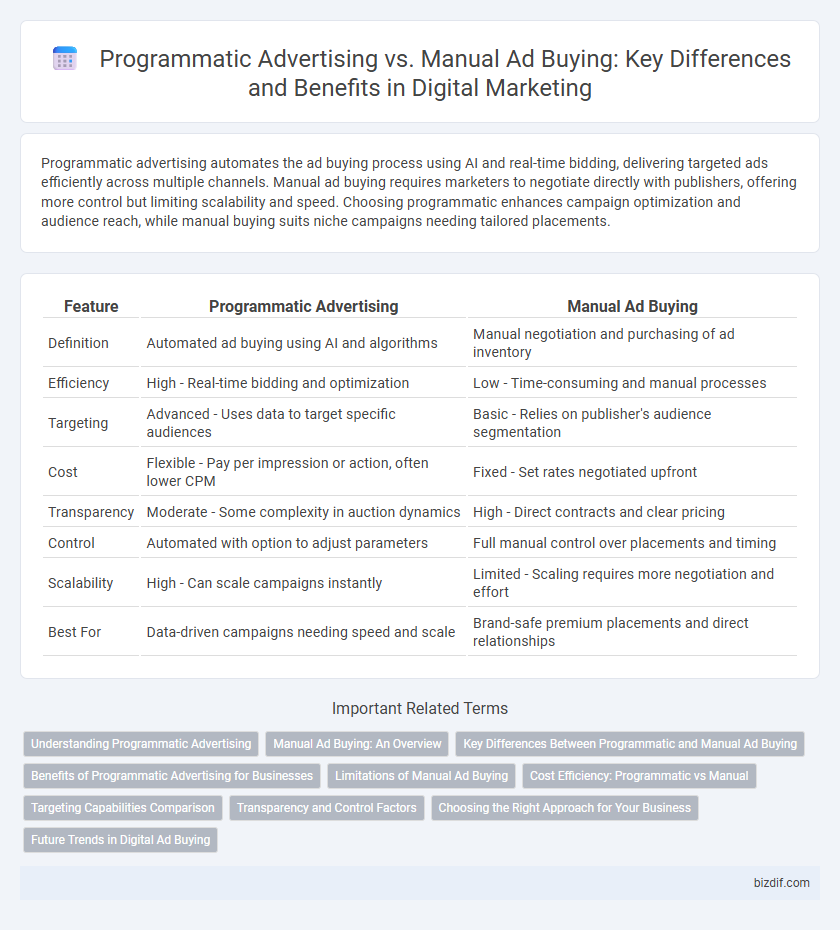Programmatic advertising automates the ad buying process using AI and real-time bidding, delivering targeted ads efficiently across multiple channels. Manual ad buying requires marketers to negotiate directly with publishers, offering more control but limiting scalability and speed. Choosing programmatic enhances campaign optimization and audience reach, while manual buying suits niche campaigns needing tailored placements.
Table of Comparison
| Feature | Programmatic Advertising | Manual Ad Buying |
|---|---|---|
| Definition | Automated ad buying using AI and algorithms | Manual negotiation and purchasing of ad inventory |
| Efficiency | High - Real-time bidding and optimization | Low - Time-consuming and manual processes |
| Targeting | Advanced - Uses data to target specific audiences | Basic - Relies on publisher's audience segmentation |
| Cost | Flexible - Pay per impression or action, often lower CPM | Fixed - Set rates negotiated upfront |
| Transparency | Moderate - Some complexity in auction dynamics | High - Direct contracts and clear pricing |
| Control | Automated with option to adjust parameters | Full manual control over placements and timing |
| Scalability | High - Can scale campaigns instantly | Limited - Scaling requires more negotiation and effort |
| Best For | Data-driven campaigns needing speed and scale | Brand-safe premium placements and direct relationships |
Understanding Programmatic Advertising
Programmatic advertising uses automated technology and algorithms to buy and optimize digital ad space in real-time, improving efficiency and targeting precision. This method leverages vast data sets and artificial intelligence to deliver personalized ads to specific audience segments, increasing ROI compared to manual ad buying. Manual ad buying relies on human negotiation and fixed placements, often resulting in less flexibility and higher costs.
Manual Ad Buying: An Overview
Manual ad buying involves directly negotiating and purchasing advertising space from publishers or platforms without automated systems, giving advertisers greater control over placements and targeting. This traditional approach often requires extensive market knowledge, time investment, and close relationships with media vendors to optimize ad spend and campaign performance. Despite the rise of programmatic advertising, manual buying remains valuable for brands seeking customized deals and niche audience targeting in specific markets.
Key Differences Between Programmatic and Manual Ad Buying
Programmatic advertising automates the buying process using AI and real-time bidding, allowing precise targeting and faster campaign adjustments. Manual ad buying relies on human negotiation and fixed placements, providing more control but limited scalability and slower response times. Programmatic excels in efficiency and data-driven optimization, while manual buying suits niche markets requiring personalized strategy and direct publisher relationships.
Benefits of Programmatic Advertising for Businesses
Programmatic advertising leverages advanced algorithms and real-time data to automate ad purchasing, enhancing targeting precision and campaign efficiency. Businesses benefit from cost-effective budget allocation and improved ROI by reaching niche audiences with personalized content. The automation also reduces human error, enables faster campaign adjustments, and provides extensive analytics for data-driven decision-making.
Limitations of Manual Ad Buying
Manual ad buying often suffers from inefficiencies such as slower campaign setup and limited targeting precision compared to programmatic advertising. It restricts advertisers to predefined channels, resulting in less dynamic audience segmentation and ineffective budget utilization. These limitations reduce overall campaign performance and hinder real-time optimization based on data analytics.
Cost Efficiency: Programmatic vs Manual
Programmatic advertising leverages automated algorithms to optimize ad placements in real-time, significantly reducing cost per acquisition compared to manual ad buying. Manual ad buying involves human negotiation and manual insertion orders, often leading to higher operational costs and less precise budget allocation. Data-driven targeting and real-time bidding in programmatic campaigns ensure more cost-efficient ad spend with improved ROI.
Targeting Capabilities Comparison
Programmatic advertising leverages advanced algorithms and real-time data to deliver highly precise audience targeting, optimizing ad spend and engagement by automatically adjusting to user behavior. In contrast, manual ad buying relies on predefined audience segments and human decision-making, which may limit targeting accuracy and responsiveness. The superior data integration and machine learning capabilities of programmatic advertising provide more granular and dynamic targeting compared to the static approach of manual ad buying.
Transparency and Control Factors
Programmatic advertising offers enhanced transparency through real-time data analytics and automated bidding processes, enabling advertisers to track campaign performance with precision. Manual ad buying provides advertisers with granular control over ad placements and targeting, though it may lack the comprehensive visibility found in programmatic platforms. Balancing transparency and control depends on campaign goals, with programmatic excelling in data-driven insights and manual buying offering hands-on decision-making power.
Choosing the Right Approach for Your Business
Programmatic advertising leverages AI algorithms and real-time bidding to optimize ad placements and targeting at scale, offering efficiency and precision for businesses aiming to maximize ROI. Manual ad buying provides greater control and customization, ideal for brands with niche markets or specific campaign goals requiring human oversight. Selecting the right approach depends on factors like budget, target audience complexity, and campaign agility needs to align marketing efforts with business objectives effectively.
Future Trends in Digital Ad Buying
Programmatic advertising is rapidly evolving with advancements in artificial intelligence and machine learning, enabling highly precise audience targeting and real-time bidding efficiency. Manual ad buying will continue to decline as marketers seek scalable solutions that optimize budget allocation and improve campaign performance through automation. Emerging trends emphasize the integration of cross-channel data and privacy-compliant strategies to enhance personalization and measurement accuracy in digital ad buying.
Programmatic advertising vs Manual ad buying Infographic

 bizdif.com
bizdif.com